Yoga – the secret to maintaining a healthy heart

Every thirty minutes, one Australian loses their life to heart disease; according to the Australian Institute of Health and Welfare, 6.2 percent of adults (1.2 million) had one or more issues related to heart, stroke or vascular diseases in 2017-18. In fact, cardiovascular diseases were the major cause of 42,300 deaths in 2019.
Furthermore, a number of underlying reasons are responsible for heart-related disease in people, including smoking, poor diet, lack of exercise, high blood pressure, etc. And that is where yoga can make a considerable difference.
It enhances cardiovascular health in several ways, from calming the nervous system and reducing disease-causing inflammation to taming hypertension and boosting beneficial HDL cholesterol. It also improves circulation and lung function and may even reduce heart disease risk as effectively as brisk walking and cycling.
Let us take a look at some of the most essential ways in which yoga can benefit you
It helps to Relax
Stress can lead to increased behaviours and other factors that elevate heart disease risk. These include smoking, physical inactivity, overeating, and high blood pressure.
Studies show that yoga can help improve mental health, increase feelings of relaxation, and improve a person’s mood among people who practice it.
The mind-body practice helps regulate the parasympathetic nervous system, part of the nervous system that tells you to calm down.
A study published in August 2020 in Stress & Health showed that yoga classes with breathing exercises and meditation reduced perceived stress and increased mindfulness in its participants.
Reduces Hypertension
According to a systematic review published in September 2021 in Scientific World Journal, yoga may play a role in managing prehypertension. Researchers reviewed a handful of studies that found meditation, breathing, and yoga exercises decreased both systolic and diastolic blood pressure (the top and bottom number on a blood pressure reading) in patients with prehypertension.
While the review didn’t provide a structured “dose” of yoga poses and breathing techniques, the study authors concluded yoga could help reduce the chances of developing high blood pressure or heart disease.
Soothes Irregular Heartbeat
Atrial fibrillation, or afib, is an abnormal heart rhythm characterised by rapid and irregular beating that can lead to stroke and other complications. According to a study presented at the European Society of Cardiology Congress in 2020, practising yoga could help people with a fib manage their symptoms.
The study enrolled 538 participants from 2012 to 2017. For 12 weeks, participants didn’t do yoga, then for 16 weeks, they attended 30-minute yoga sessions every other day, which included postures and breathing. During the 16 weeks, participants experienced a drop in the number of episodes.
A few Yoga Asanas for your heart
Easy Pose (Sukhasana)
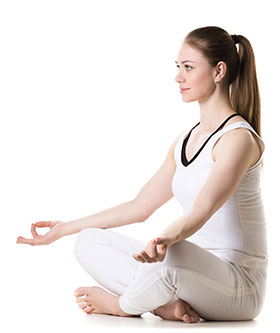
This simple seated posture can be done as a mini meditation at the beginning and end of your practice. Sit in a comfortable cross-legged position with your right shin in front of your left. If your hips are tight, sit on a folded blanket or bolster to make it easier to keep your back straight and your shoulders relaxed and down.
Rest your hands, palms facing up, on your knees, close your eyes, and focus on inhaling to a count of two and exhaling to a count of four. When your mind wanders and it will just refocus on your breath.
Suggested time: 3 to 5 breaths
Mountain Pose (Tadasana)
This basic pose calms the mind, sharpens focus and improves circulation. Stand with your feet parallel and hip-width apart. Firm your thighs to lift your kneecaps (don’t lock the knees). Lift your toes to activate your arches and inner ankles. Release your toes back down, keeping your feet active.
Lengthen your tailbone down and engage your abdomen to protect your lower back. Keep your shoulders back and down while widening your collarbones and lifting your sternum. Imagine a straight line running from the centre of your ankles all the way up through the crown of your head. Keep your eyes soft and breathe deeply.
Suggested time: 3 to 5 breaths

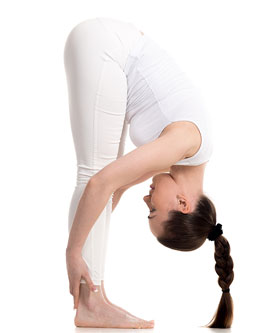
Standing Forward Bend (Uttanasana)
You can do this move without props, but supporting your head on blocks (or even a chair) enhances this relaxing pose’s calming benefits. Standing in Mountain Pose with your hands on your hips, inhale and then exhale as you bend from the hips and fold forward, keeping your front torso long. Rest the crown of your head on the blocks and grasp your ankles with your hands. Keep your knees slightly bent if your hamstrings are tight. If you’re prone to back problems, move your feet farther apart, keeping them parallel.
Suggested time: 3 to 5 breaths
Big-Toe Pose (Padangusthasana)
This is an easy asana to relieve stress and chill out. Standing in Mountain Pose, inhale and exhale as you bend from the hips and grasp your big toes with each hand’s thumb, forefinger and middle finger. Inhale as you straighten your back, exhale, and fold forward, keeping your front torso long. Keep your knees slightly bent if your hamstrings are tight.
Suggested time: 3 to 5 breaths
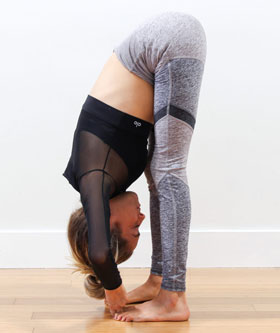
Downward Dog (Adho Mukha Svanasana)
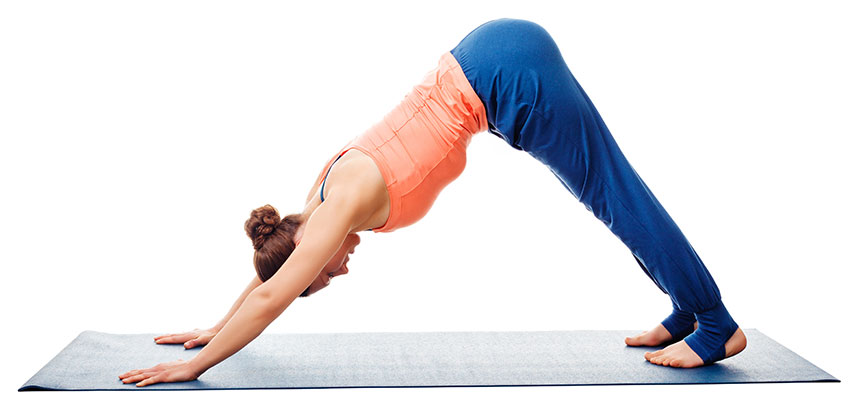
Resting your head on a bolster, block, or folded blanket enhances this asana’s calming benefits. Begin on your hands and knees, with your hands shoulder-width apart slightly in front of your shoulders and your knees directly below your hips. Spread your palms with your index fingers parallel.
Exhale, tuck your toes and straighten your legs as you lift your hips to create a modified inverted “V.” Rest your head on the bolster to keep it aligned with your arms. Straighten your legs (but don’t lock your knees) and press your heels toward the floor. Tilt your pelvis to create length in your lower back. Keep the knees slightly bent if your hamstrings are tight.
Suggested time: Hold for five breaths
Head-To-Knee Forward Bend (Janu Sirsasana)

This seated forward bend gently stretches your hamstrings and groin. Sitting on the floor with both legs extended in front of you, inhale as you bend your left knee to bring your left sole alongside your right inner thigh (avoid pressing your foot against your knee). Keep your right foot flexed.
Exhale, keeping your back long and flat, bend from your hips and fold forward until you feel a gentle stretch in your right hamstring. Rest your hands on either side of your extended leg, or if you’re more limber, grasp your right foot with your hands. Repeat on the other side.
Suggested time: Hold for 3 to 5 breaths on each side
Bridge Pose (Setu Bandha Savangasana)
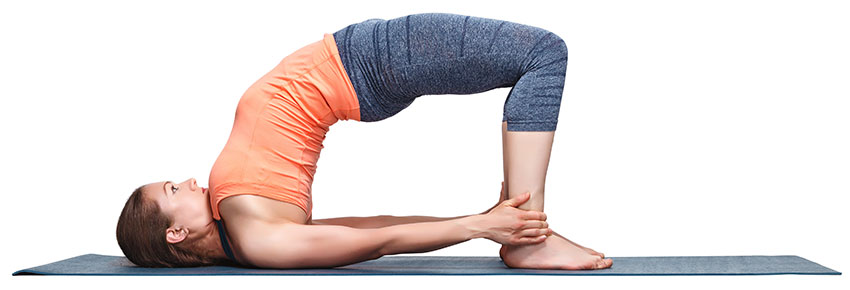
Lie on your back, arms at your sides and palms down. Bend your knees, bringing your heels as close to your sitting bones as possible. Place your feet hip-width apart and parallel. Exhale, pressing down through your feet and hands while lifting your hips until your thighs are parallel to the floor.
Firm your buttocks and tilt your tailbone up to lengthen your lower back. To deepen the pose, roll your shoulders under, clasp your hands as you press your sternum toward your chin, and broaden your shoulder blades. If your shoulders are tight, extend your arms and palms down alongside your body.
Suggested time: Hold for 3 to 5 breaths, coming out of the pose on an exhalation.







